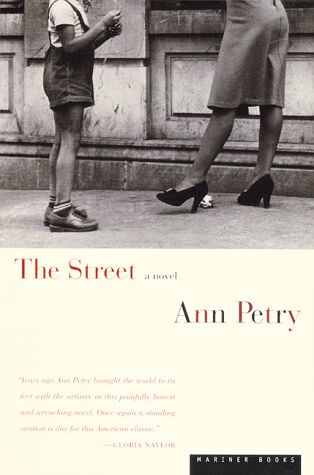 |
|
 |
 |
|
 |
As far as I know, there have been three major publishers of Ann Petry's novel, The Street. Each one used a different cover image to sell the novel to readers. The most common publisher has used three different cover illustrations, in the 1940s, 1990s and now in the 2000s. Each of these cover illustrations sends different messages to the reader about the contents of the book.
 This
is the most recent cover. Houghton Mifflin is still the publisher,
but it is now published under an imprint, Mariner Books. There
is no new publishing date since this is rightfully just later
printings, but copies of this version starting showing up in the
bookstore in late 2000.
This
is the most recent cover. Houghton Mifflin is still the publisher,
but it is now published under an imprint, Mariner Books. There
is no new publishing date since this is rightfully just later
printings, but copies of this version starting showing up in the
bookstore in late 2000.
This cover is much more striking than the other covers. The muted color scheme and the use of the B&W photo give the novel a sense of importance. Whereas the 1960s paperback tried to sell the novel as a contemporary sexed up novel like Valley of the Dolls or Peyton Place, this cover clearly sends the signal of respectability. I've had more than a few students indicate that "it looks like an Oprah book."
The clothing styles shown here are Lutie in a simple business type skirt, similar to what we would expect a civil servant to wear. The young boy's clothes, however are more dated and when combined with the B&W photography, gives a sense of age and nostalgia to the contents.
The relationship between the woman and the boy is clearly one of authority. The woman appears to be chastising the young boy, who is doing his best to listen, but not really. The boy's attention is more on what is in his hands, not what his mother is saying. The body language of the mother is stern and disciplinary. While the Lutie on the 1991 cover could be seen as putting her hand on Bub's shoulder in protection and comfort, the mother on this cover is scolding according to the body language.
The B&W photo by itself gives a sense of age and a certain amount of "dirtiness," but the age of the building in the background is clear. The single ball of paper next to the mother's foot, casually discarded, seems more significant than the images of blowing paper on the 1960s and 1985 covers. The ball of paper doesn't make an impression of the street's general nature, but it does imply the disposability and transitory nature of things considered garbage which carries over to all the people living on the street in the novel.
The quote from Gloria Naylor is still used on the cover, still not as emphasized as on the 1985 cover, but somehow more easily noticed than on the 1991 cover. Here, unlike the 1991 cover, instead of adjusting the number of years, the quote is simply truncated to reference an unspecified number of years in the past.
|
Covers HomePage |
 |

|
 |
 |
|